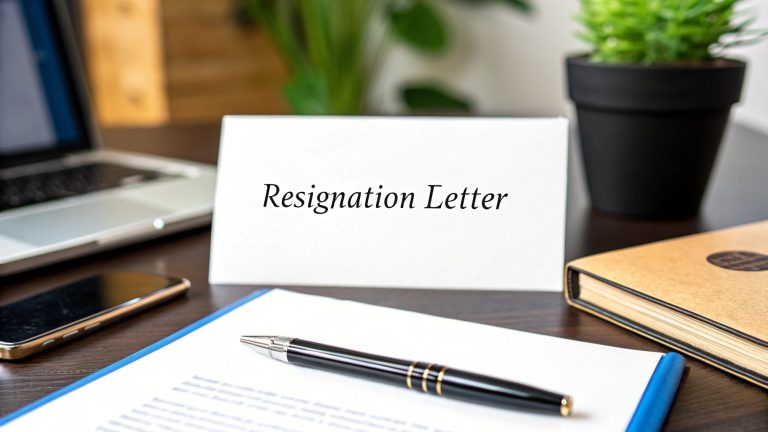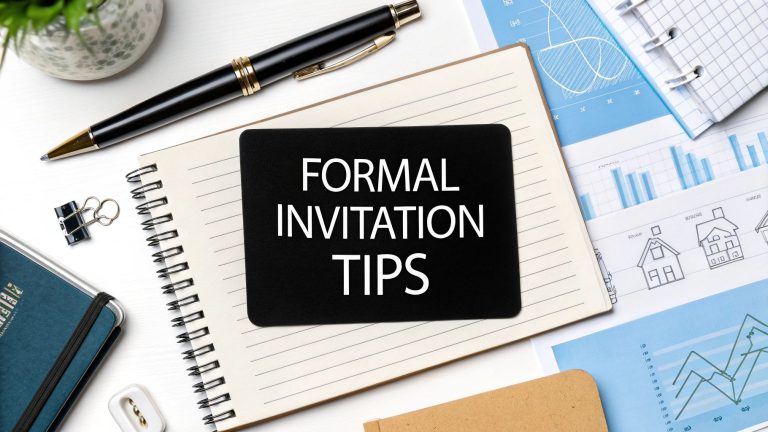A job offer letter template isn't just a fill-in-the-blanks document. It's your blueprint for formally welcoming a new hire, laying out all the essential terms of employment in one clear, professional package. Think of it as the official, written confirmation that follows up on your verbal offer, covering everything from salary and start date to benefits and any pre-employment checks.
This document is the final, critical bridge between a great interview and a signed contract.
Why Your Job Offer Letter Matters More Than Ever

Sending a job offer is so much more than the last step in the hiring process. It's your first real opportunity to prove that your company is the right choice for your top candidate. A generic, uninspired letter just won't cut it anymore, especially when you're competing for top talent.
The best way to think about it is as a crucial marketing tool. A well-crafted offer letter sets the tone for the entire employee experience, reflecting your company's culture and values from the very first interaction. It turns a dry formality into an exciting confirmation, making your candidate feel genuinely valued and confident they've made the right decision.
Setting Expectations in a Candidate-Driven Market
Today's hiring world is all about transparency. Candidates have higher expectations and more information at their fingertips than ever before. For example, with over 40 percent of job postings now including salary ranges, people come to the table with a solid understanding of their market value.
This shift means your offer letter has to be crystal clear, comprehensive, and, most importantly, compelling. It needs to do three things exceptionally well:
- Reinforce the Full Value: Don't just list the salary. Clearly articulate the entire compensation package, including benefits, bonuses, and equity.
- Build Excitement: Ditch the robotic corporate-speak. Use a warm, welcoming tone that shows off your company’s personality.
- Provide Total Clarity: Leave no room for confusion. Spell out the role, responsibilities, reporting structure, and what happens next.
A great job offer letter doesn’t just state the facts; it sells the opportunity. It’s the final pitch that can seal the deal, reduce negotiation friction, and kick off a positive long-term relationship.
Since a job offer is one of the most important transactional emails you'll ever send, applying broader engagement principles can really make it shine. Digging into transactional email best practices can help ensure your message lands with the impact it deserves.
Ultimately, having a solid template ensures you hit all the legal and practical marks every time, while still leaving room for the personal touches that make a candidate feel truly wanted.
Before we dive into building your template, let's quickly review the core components that every modern job offer letter should include.
Essential Components of a Modern Job Offer Letter
This table breaks down the non-negotiable elements you need to include for a clear, comprehensive, and legally sound job offer.
| Component | What to Include | Why It's Important |
|---|---|---|
| Company Branding | Your company logo, name, and address. | Establishes professionalism and reinforces your brand identity from the start. |
| Candidate Details | The candidate's full name and address. | Ensures the offer is officially addressed to the correct individual. |
| The Role | The official job title and the department they'll be joining. | Provides absolute clarity on the position being offered, avoiding any confusion. |
| Compensation | Base salary, pay frequency (e.g., bi-weekly), and any bonus potential. | This is often the first thing candidates look for. Transparency here builds trust. |
| Key Dates | The proposed start date and the deadline to accept the offer. | Creates a clear timeline and a sense of urgency for the candidate's decision. |
| Employment Contingencies | Any conditions like background checks or reference checks. | Manages expectations and legally protects the company if conditions aren't met. |
Getting these basics right is the foundation of an offer that not only attracts but also secures the talent you need to grow.
Building the Core of Your Offer Letter
Creating a solid job offer letter template isn't just about plugging in names and numbers. It’s about building the essential framework that makes your offer clear, compelling, and professional. Think of it as the skeleton—you'll add the unique details for each role later, but a strong core structure ensures nothing gets missed.
The real goal here is to create a reliable foundation you can use for any hire, whether it's an intern or a new C-suite executive. The specifics will change, but the main sections stay the same, giving you consistency and saving you from reinventing the wheel every time.
Defining the Position with Precision
First things first, you have to nail down the role itself. This part is more than just stating the job title; it's your chance to help the candidate truly picture themselves at the company. It makes the abstract idea of a "new job" feel tangible and real.
A solid "Position Details" section should always cover:
- Official Job Title: Be specific, like "Senior Content Strategist."
- Reporting Structure: Name their direct manager and their title. This small touch instantly makes the offer feel more personal.
- Key Responsibilities Summary: A quick one or two-sentence summary of what they'll be doing. It’s a great way to reinforce the most important parts of your interview conversations.
- Employment Status: Clearly state if the role is full-time, part-time, or contract, and specify whether it's exempt or non-exempt.
Getting this right from the start prevents any confusion down the line and shows the candidate you're both on the same page about their future at the company.
Articulating the Full Compensation Package
Next up is compensation. Let's be honest, this is the section candidates scrutinize the most, so total transparency is your best friend. Don't just throw out a single salary number; break down the entire financial offer to show them the full value you're bringing to the table.
A great compensation summary always includes:
- Base Salary: State the gross pay and how often it's paid (e.g., "$85,000 per year, paid bi-weekly").
- Bonus Potential: If there's a bonus, explain how it works. For example, "eligible for an annual performance-based bonus of up to 15% of your base salary."
- Equity or Stock Options: If you offer equity, give a brief overview of the grant, like the number of shares and the vesting schedule.
This infographic shows how these key pieces—the position, compensation, and benefits—all fit together to create a complete offer.
As you can see, each piece adds another layer of detail, building a comprehensive and attractive offer that helps the candidate see the big picture.
Outlining Benefits and Offer Contingencies
Finally, let’s wrap up the core offer by talking about benefits and any necessary contingencies. Instead of just listing perks, frame your benefits as an investment in your team's well-being. If you're looking for inspiration, the phrasing in a good promotion offer letter template can be a great resource, as they are often designed to highlight growth and company value.
A well-crafted offer letter anticipates questions. By clearly outlining contingencies like background checks or proof of work eligibility, you maintain legal protection without sounding confrontational. Use neutral, standard language to set these expectations professionally.
With this foundation in place, your job offer letter template becomes more than just a legal document—it's a powerful tool for convincing your top choice to say "yes."
Presenting Compensation and Benefits Effectively

Let's be honest: top candidates aren't just looking at the salary figure. They're weighing the entire package. The way you present your compensation and benefits can make all the difference, turning a potential negotiation headache into a quick "yes!" This section of the offer letter is your chance to tell a compelling story about how much your company invests in its people.
Instead of just dropping a number, think of it as presenting a "Total Rewards" package. This simple shift in framing moves the conversation from a single data point to the comprehensive value you're offering. It helps candidates see the full picture of what working with you really means and justifies the offer you’re making.
Breaking Down the Financials
When it comes to money, clarity builds trust. A vague offer just creates doubt, but a detailed breakdown shows you're transparent and have nothing to hide. You want to go beyond the base salary and paint a clear picture of the candidate's full earning potential.
Start with the basics: the annual salary and how often they’ll be paid. From there, detail any performance-based incentives right away. This proactive approach answers their biggest questions before they even have a chance to ask.
Here’s a practical way to structure this in your template:
- Base Salary: Clearly state the gross annual salary (e.g., "$95,000 per year") and mention the pay schedule (e.g., "paid bi-weekly").
- Performance Bonus: If you offer one, explain the structure. For example, "You will be eligible for an annual performance bonus of up to 10% of your base salary, based on company and individual performance goals."
- Equity or Stock Options: Keep the initial explanation simple. Something like, "You will be granted 1,000 Restricted Stock Units (RSUs) that vest over a four-year period," is perfect.
This level of detail helps a candidate do the math and understand their real take-home potential, making your offer feel more concrete and far more appealing.
Explaining Benefits in Human Terms
Benefits are a massive part of your value proposition, but they often get buried in a dry, jargon-filled list. It's time to transform that section from a legal disclosure into a powerful showcase of your company culture and commitment to employee well-being. Don't just list what you offer; explain why it matters.
For example, instead of just writing "Health Insurance," try framing it as, "Comprehensive health, dental, and vision insurance to keep you and your family healthy." That small tweak makes the benefit feel more personal and valuable.
Your goal is to make complex benefits understandable at a glance. A candidate shouldn't need an employee handbook and a dictionary just to figure out your 401(k) match or PTO policy.
To make the benefits section easy to scan, use clear headers and simple, human-centric language. Here’s an example of what that could look like:
- Paid Time Off: "We offer 20 days of PTO per year, plus 10 paid company holidays, because we know how important it is to rest and recharge."
- Retirement Savings: "Secure your future with our 401(k) plan, which includes a company match of 100% on the first 4% of your contributions."
- Professional Development: "We invest in your growth with an annual stipend of $2,000 for you to use on courses, conferences, and certifications."
Presenting the full package this way also gives you a huge advantage if the candidate gets a competing offer. When you've already laid out your total rewards, you've made a powerful, proactive case for why your offer is the one to beat. You can even check out these counter offer letter examples to see how both sides articulate value beyond just the salary number.
Infusing Your Offer with Company Culture

Think about this: beyond the salary and the legal details, your offer letter is the first real taste a candidate gets of your company's personality. A dry, overly formal document can signal a rigid, bureaucratic workplace. On the other hand, a warm, authentic letter can make someone feel like part of the team before they even sign.
This is your chance to turn a standard template into a powerful welcome. You spent the entire interview process showing off your great culture, so don't let the offer letter create a disconnect. If your team is collaborative and creative, a stuffy, boilerplate offer letter just feels wrong. Use language that sounds like you.
Make a Personal Connection
One of the easiest ways to inject your culture into the offer is with a quick, personal note right from the hiring manager. Adding just a sentence or two at the beginning can make a massive difference.
It doesn’t have to be a novel. Something as simple as, “We were all so impressed with your ideas for the new marketing campaign, and I’m personally excited to start working with you on them,” changes everything. It turns a transaction into a genuine invitation.
An offer letter is more than a legal document; it's a piece of communication. Its tone should align with your company’s values, whether that's energetic and creative or thoughtful and mission-driven.
This simple touch is a cornerstone of good letter writing etiquette and starts building a strong relationship from day one.
Paint a Picture of Their Future
Help your top candidate see themselves succeeding at your company. Give them a glimpse of what's to come, which builds excitement and shows them they’re joining a team with real momentum.
You can do this by adding a short section that covers things like:
- Connecting to the Mission: Briefly tie their role to the bigger picture. For instance, "Your work as a Software Engineer will directly help us in our mission of making financial literacy accessible to everyone."
- A Glimpse of Week One: Give them a sneak peek. Mentioning something like, "Your first week will be focused on meeting the team and getting up to speed on Project Apollo," makes the start date feel real and less intimidating.
This is also a great place to highlight things that matter in today's job market. As hiring becomes more skills-focused, many companies are calling out upskilling opportunities or flexible work arrangements directly in the offer. It's a smart way to attract people who are looking to grow.
Weaving these elements into your job offer letter template does more than just outline the terms of employment. It creates a document that truly welcomes your new hire into the fold.
Navigating Legal Clauses and Disclaimers
While you want your offer letter to feel warm and exciting, it's also a critical legal document. This is the part where you need to switch gears slightly, moving from "selling" the role to protecting your company with clear, precise language.
Think of these clauses as the necessary fine print that establishes professional boundaries right from the start. It’s not about being cold or intimidating; it’s about being transparent and preventing future headaches. A solid grasp of contract formation in business law is essential here, as it ensures your offer is both legally sound and crystal clear for everyone involved.
The At-Will Employment Statement (A Must-Have)
In nearly every U.S. state, including an "at-will employment" clause is absolutely non-negotiable. This statement simply clarifies that the working relationship can be ended by either the employee or the company at any time, for any reason (provided it's not an illegal one), with or without notice.
Why is this so important? It prevents the offer letter from being misinterpreted as a binding contract for a set period. It’s a standard, foundational piece of protection that manages expectations from day one.
Here’s a straightforward way to phrase it:
"Your employment with [Company Name] will be 'at-will,' meaning that either you or [Company Name] may terminate the employment relationship at any time, with or without cause or notice."
How to Handle Offer Contingencies
Most job offers aren't set in stone until a few final boxes are checked. These conditions, or contingencies, need to be spelled out clearly in the letter. The key is to frame them as standard procedure, not a sign of distrust.
Common contingencies you'll want to build into your job offer letter template include:
- Background Check: "This offer is contingent upon the successful completion of a background check satisfactory to the company."
- Proof of Work Eligibility: "As required by federal law, this offer is contingent upon you providing legal proof of your identity and authorization to work in the United States."
- Reference Checks: "This offer is conditional upon satisfactory reference checks from your previous employers."
Wording them this way normalizes the process and keeps the tone professional and welcoming.
Protecting Confidential Information
Your new hire is about to get access to sensitive company data. A confidentiality clause, sometimes called a Proprietary Information and Inventions Agreement (PIIA), establishes the expectation that they must keep this information private.
This clause makes it clear that the employee agrees not to share things like trade secrets, customer lists, or internal financial reports, both during and after their time with you. They’ll probably sign a more detailed document later, but mentioning it in the offer letter sets the stage.
A simple heads-up is all you need. For example:
- "As a condition of your employment, you will be required to sign and comply with our standard Confidentiality and Intellectual Property Agreement."
This sentence lets the candidate know another document is coming, so there are no surprises during onboarding. Getting these legal details right from the jump makes your offer both inviting and secure.
Answering Common Questions About Job Offer Letters
Even with the best template in hand, you're bound to run into some tricky questions when extending a job offer. It happens to all of us. Handling these moments with confidence is what separates a good hiring process from a great one. Let's walk through a few of the most common questions I've seen pop up over the years.
Is the Offer Letter a Legal Contract?
This is a big one. In the U.S., the short answer is no, a job offer letter is generally not considered a legally binding contract. Think of it as a formal invitation to an employment relationship.
Most offer letters include an "at-will employment" clause, which clarifies that either party can end the relationship at any time. The real legally binding document is the formal employment contract that comes later. Still, be careful with your wording—avoid any language that sounds like a promise of employment for a specific period. It keeps things clear for everyone.
How Long Should We Give a Candidate to Decide?
Finding the right balance for a response deadline can be tough. You don't want to rush a great candidate, but you also can't leave the role in limbo forever.
A good rule of thumb is to give them three to five business days. This is the professional standard and shows you respect their need to think things through. It’s enough time for them to review everything without slowing down your hiring momentum.
Keep in mind the current market is a bit different. According to recent data, the average time to get a first offer has jumped by 22 percent to 68.5 days. Things are moving slower, so a reasonable deadline is more important than ever. You can read more about current job search trends at Huntr.co.
A signed offer letter is the candidate's formal "yes" to your terms. This is the green light that kicks off the next phase: sending the employment contract and getting the onboarding process started.
What’s the First Thing to Do After They Accept?
They said yes! Now what? Don't just file the signed letter and move on. Your immediate response sets the tone for their entire experience with your company.
The best move is to send a quick, enthusiastic confirmation email right away. Make sure it covers a few key things:
- Show your excitement! A simple "We're thrilled to have you join us!" goes a long way.
- Reconfirm the details. Lock in their start date and outline what's next.
- Set expectations. Let them know what their first day or week will look like.
This quick follow-up makes them feel welcome and keeps the energy high. It's also a nice touch to share resources, like our guide on examples of acceptance letters, so they can see what a great response looks like.
Anticipating these common questions helps you manage the final stages of hiring with poise, ensuring your new team member's journey starts off on the right foot.
Crafting the perfect letter for any situation can be time-consuming. AI Letter Generator uses intelligent technology to create polished, professional letters in seconds. Whether you're sending a job offer, a thank you note, or a formal business inquiry, our tool helps you communicate clearly and effectively. Try it for free and see how easy it can be at https://lettergenerator.co.




